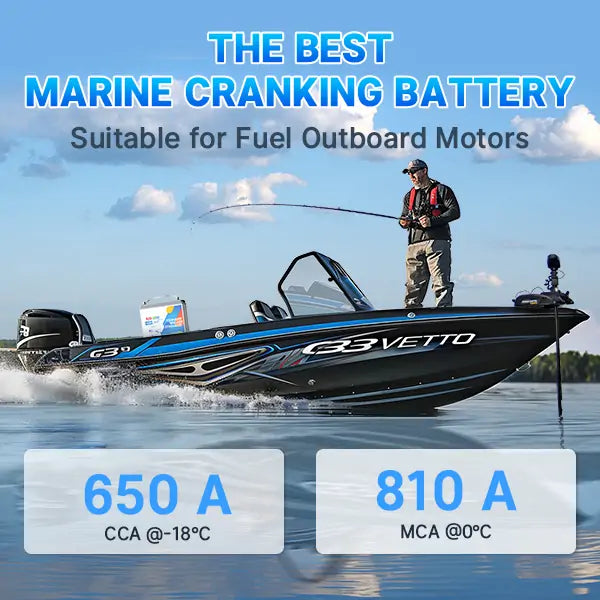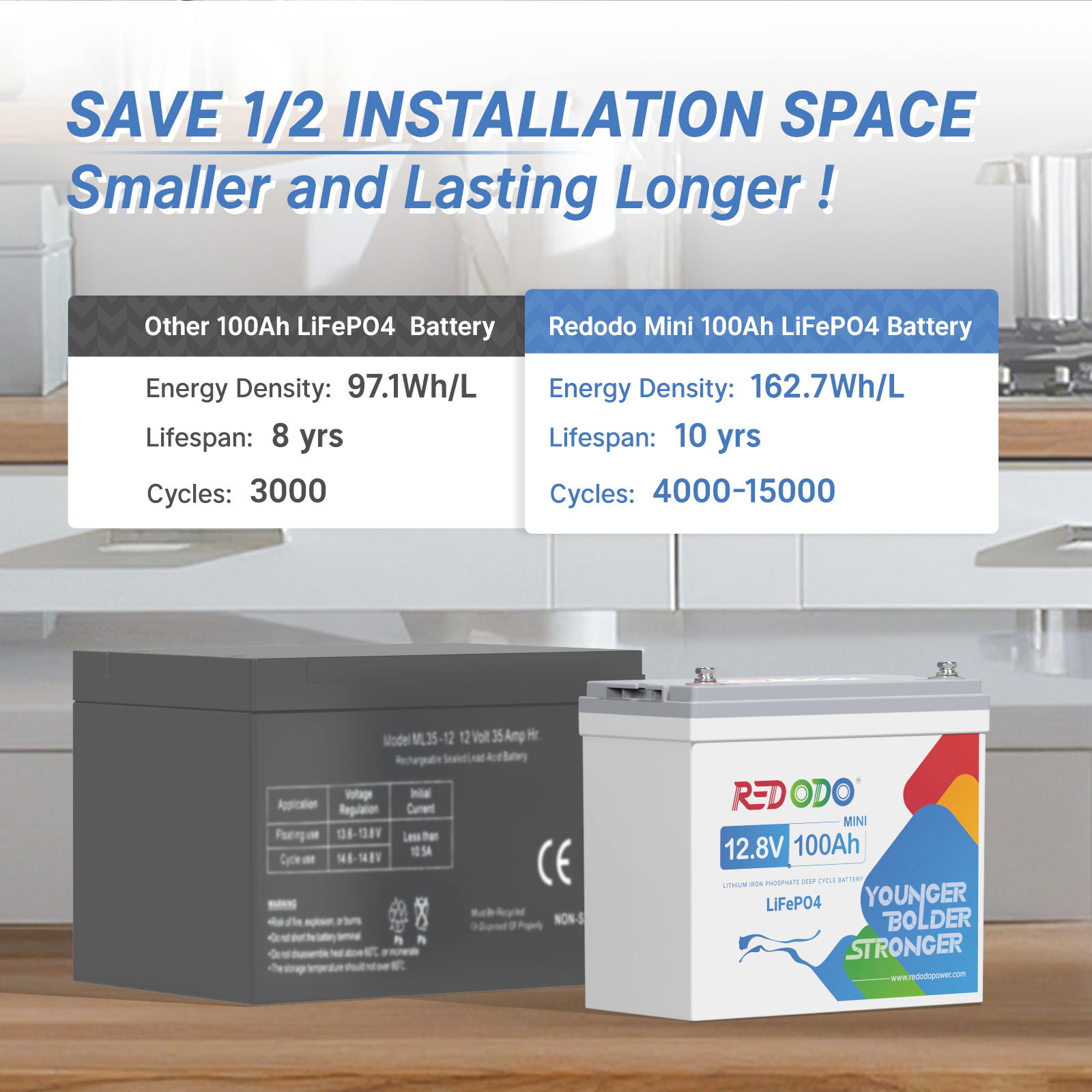Deep Cycle vs. Starting Battery: How to Choose
Batteries are an essential component of countless applications, ranging from automotive vehicles, boats to renewable energy systems. When it comes to powering marines and RVs, the choice between deep cycle and starting batteries can significantly impact performance and longevity.
In this article, we will dive into the deep cycle vs starting batteries. By understanding their key differences, you can make an informed decision when selecting the right battery for your specific needs.
Table of Content
Part 1: Understanding Starting Battery
Starting batteries, also known as a cranking or starter batteries, are specifically designed to provide high bursts of power for short durations to start an engine. They deliver a large amount of current to crank the engine and get it running.
Starting batteries are built with thinner plates and higher surface area, allowing them to deliver a large amount of current instantly.
Features of Starting Batteries
- Capacity: Starting batteries have a high capacity to deliver a large amount of current in a short period of time. This is necessary to start the engine of a vehicle, which requires a high current surge.
- Cranking Amps (CA): Starting batteries have a high cranking amp rating, which represents the amount of current the battery can deliver for 30 seconds at 32°F (0°C) while maintaining a voltage of at least 7.2 volts.
- Cold Cranking Amps (CCA): CCA is similar to CA but measured at 0°F (-18°C). It represents the battery's ability to deliver current in cold weather conditions when engines are harder to start due to increased viscosity of engine oil.
- Reserve Capacity (RC): Reserve capacity is the number of minutes a fully charged battery can deliver a constant 25-ampere current before its voltage falls below 10.5 volts. It indicates the battery's ability to power electrical components in case of alternator failure or extended idling.
Typical Applications Where Starting Batteries are Used
Starting batteries are primarily used in automotive applications, where their main function is to provide a high burst of power to start a vehicle's engine. Here are some typical applications where starting batteries are commonly used:
- Automobiles: Starting batteries are essential components of cars, providing the power required to start the engine and operate the vehicle's electrical systems while the engine is running.
- Motorcycles: Whether it's a small scooter or a powerful motorcycle, starting batteries are crucial for initiating the engine's combustion process and powering the motorcycle's electrical systems.
- Boats: Boats with outboard motors or inboard engines require starting batteries to kick-start the engines and power the boat's electrical equipment such as lights, navigational aids, and radio systems.
- Lawn and Garden Equipment: Many gas-powered lawn mowers, chainsaws, and other yard-care equipment require starting batteries to initiate the engine's operation.
- Generators: Portable and standby generators often utilize starting batteries to provide the initial power needed to start the engine and generate electricity.
Explore the Redodo 12V Marine Cranking Battery, which is equipped with top-grade automotive-grade battery cells to ensure maximum safety and reliability.

Part 2: Exploring Deep Cycle Battery
Deep cycle batteries are designed to provide a steady amount of power over an extended period. They are engineered to handle repetitive deep discharges and subsequent recharges.
Deep cycle batteries have thicker plates, which enable them to withstand deep discharges without causing damage. They are built to deliver power gradually and operate for longer durations.
Redodo LiFePO4 deep cycle batteries can use up to 10% of their total capacity before requiring recharging and are good for 4000 to 15000 discharge/charge cycles, which can be used for more than 10 years.

Features of Deep Cycle Batteries
Deep cycle batteries are designed with specific features to provide sustained power over extended periods of time. Here are some key features of deep cycle batteries:
- Deep Discharge Capability: Deep cycle batteries are built to withstand repeated deep discharges without causing damage to the battery. They can be discharged to a lower state of charge, typically up to 50% or more, without affecting their performance or lifespan.
- Capacity: Deep cycle batteries typically have a higher amp-hour (Ah) rating compared to starting batteries. This means they can deliver power for longer durations, making them suitable for applications that require sustained energy, such as recreational vehicles (RVs), boats, golf carts, solar power storage, and off-grid systems.
- Thick Plates: Deep cycle batteries have thicker plates compared to starting batteries. These plates are designed to withstand repeated charging and discharging cycles, allowing for deep cycling without degradation. Thicker plates also help in providing a more stable and consistent power output.
- Durability: Deep cycle batteries are built to be more robust and durable than starting batteries. They are better able to handle vibrations and shocks, making them suitable for rough and off-road conditions.
- Slow Discharge Rate: Deep cycle batteries have a low self-discharge rate, which means they can hold their charge for extended periods without being recharged. This feature is especially useful for situations where the battery may not be in use for a while.
Typical applications where deep cycle batteries are used
Deep cycle batteries are commonly used in various applications that require sustained power over extended periods. Some typical applications include:
- Recreational Vehicles (RVs) and Boats: Deep cycle batteries are ideal for powering onboard appliances, lights, and electronics in RVs and boats. They can provide reliable and consistent power for extended periods of time, allowing for comfortable and convenient living.
- Renewable Energy Systems: Deep cycle batteries play a vital role in storing energy generated from renewable sources like solar panels or wind turbines. They can store excess energy during periods of low demand and supply it when needed, ensuring a continuous power supply.
- Off-Grid Power Systems: Deep cycle batteries are essential components of off-grid power systems commonly found in remote locations or areas with unreliable power grids. These batteries provide a reliable power source for lighting, appliances, and other electrical needs.
- Electric Vehicles: Deep cycle batteries are often used in electric vehicles, where they provide the necessary power for propulsion. These batteries are designed to handle frequent charging and discharging cycles, enabling the vehicle to operate efficiently.
- Industrial Applications: Deep cycle batteries are used in various industrial applications, such as backup power systems, forklifts, material handling equipment, and telecommunications. These batteries provide a reliable and long-lasting power source for critical operations.

Part 3: Key Differences between Deep Cycle and Starting Batteries
- Construction: Starting batteries have thinner plates, while deep cycle batteries have thicker plates, making them more durable for deep discharges.
- Discharge Capabilities: Starting batteries can deliver short bursts of high current, whereas deep cycle batteries provide a steady flow of power over an extended period.

- Performance: Starting batteries excel in cold cranking amps (CCA) to start engines, while deep cycle batteries offer a higher reserve capacity (RC) for constant power output.
- Lifespan: Deep cycle batteries have a longer lifespan compared to starting batteries, as they are designed to handle deeper discharges and recharge cycles. Redodo LiFePO4 deep cycle batteries has the life-cycle up to 4000-15000, which can be used for 10 years.
- Cost: Typically, deep cycle batteries are more expensive due to their specialized design and higher materials required for construction. But with longer lifespan, it’s still a worthy investment.
Part 4: Marine Deep Cycle vs Starting Battery
While both types of batteries can technically be used in marine applications, deep cycle batteries are generally recommended for applications that require long-lasting and consistent power delivery, such as running electrical accessories on a boat or powering a trolling motor.
When choosing between marine deep cycle batteries and starting batteries for your boat or marine application, it's important to consider your specific power needs and usage patterns. If you require sustained power delivery and are likely to deep cycle the battery regularly, a deep cycle battery would be the better choice.
FAQs about Deep Cycle and Starting Batteries
1. Which battery type is better for marine applications?
For marine applications that require consistent power delivery, such as running electrical accessories or powering trolling motors, deep cycle batteries are recommended. They can handle repeated deep discharges and provide sustained power over longer periods.
2.What are the main differences between deep cycle and starting batteries?
Deep cycle batteries have thicker plates and are built to withstand deeper discharges. They are designed for sustained power delivery and can handle regular deep cycling. Starting batteries, on the other hand, are designed for short bursts of high power to start engines and are not meant for deep cycling.
3.Can I Use Deep Cycle Battery as Starting Battery?
While it is possible to use a deep cycle battery as a starting battery, it is not recommended. Deep cycle batteries are designed to provide sustained power over longer periods and can handle repeated deep cycling. They have thicker and more robust plates.
Starting batteries, on the other hand, are specifically built for quick bursts of power to start engines. They have thinner plates that can deliver a high cranking amperage for engine start-ups. Starting batteries are not designed to handle deep cycling.
Using a deep cycle battery as a starting battery may result in reduced cranking power, shorter battery life, and potential damage to the battery. It is always best to use the right type of battery for its intended application to ensure optimal performance and longevity.
Conclusion
Selecting the correct battery type is crucial for optimal performance and longevity in your desired application. Understanding the differences between deep cycle and starting batteries, ranging from construction to discharge capabilities, allows you to make an informed decision.
Consider your specific requirements, budget, and environmental aspects when choosing between the two. By choosing the right battery, you can ensure reliable and efficient power supply for your needs.

Redodo

Redodo
Join Redodo
Related Post

How to Store a Deep Cycle Marine Battery for Winter?

What Size Solar Panel Do I Need to Charge A 12V Battery?

Light Up Your Christmas with Redodo: LiFePO4 Batteries Holiday Deals

How to Choose the Best Battery for Van Life?









